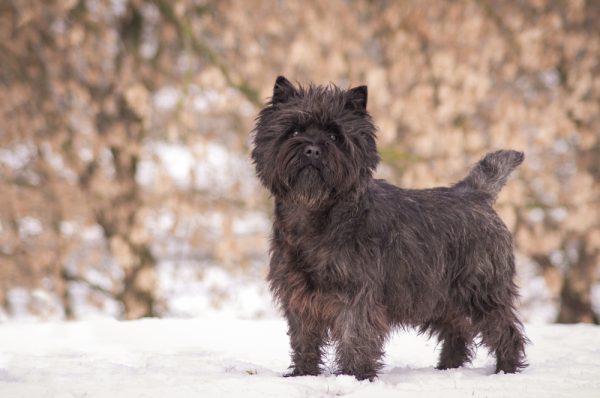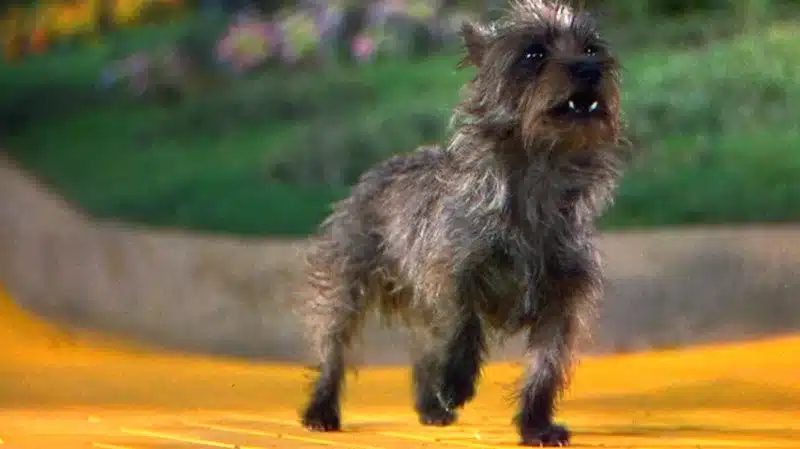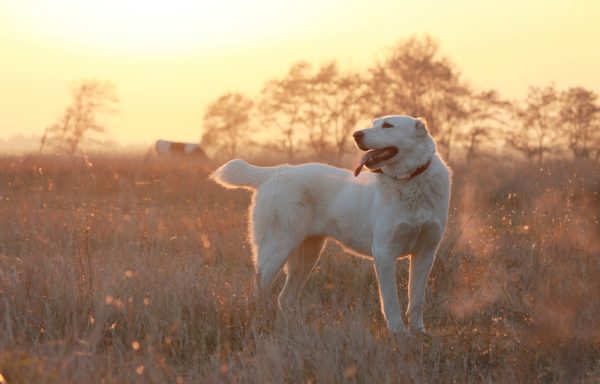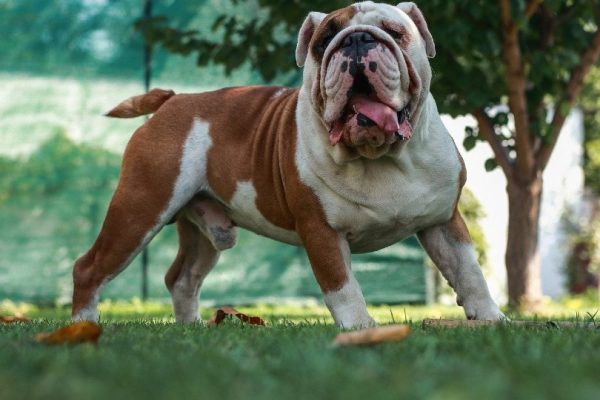Dogsters, a while back I teased an upcoming story about a mystery celebrity dog by showing a few pictures of the dog. Of course, you all guessed who it was. I also promised to tell you the rest of the story. And here I am, with a most fascinating story of one of Hollywood’s most memorable dogs: Terry, aka Toto from The Wizard of Oz. It comes to us courtesy of Allan R. Ellenberger.
Toto from The Wizard of Oz, the Story of a Dog
By Allan Ellenberger
The most indulged of all the spoiled lovelies of Hollywood during the Golden Age were the canine actors who worked in films. They had their own hotel, The Hollywood Dog Training School, where at one time, seventy-five of the best known dogs of the screen lived in tranquil comfort.
The school was set on a pleasant ten-acre site, covered with oaks and willows, near Laurel Canyon Boulevard five miles north of Hollywood. Three hundred feet back from the road stood a cream-colored frame house and back of it were two kennels, each 150 feet long. It featured southern exposure, long runs to each kennel, a large grass playground, showers in each section, and several porcelain bathtubs with hot and cold water, an electric drier and a special kitchen where, every day, a tempting cauldron full of vegetable and beef bone soup was cooked for dinners of the distinguished boarders.
The dogs, like all other actors, employed a manager the amiable Carl Spitz who drove as hard a bargain for his clients as any other agent in Hollywood. The German-born Spitz first took up the work of schooling dogs in Heidelberg where his father and grandfather were dog trainers. Spitz trained dogs for military and police service in World War days. He saw Red Cross dogs search for dying men in no mans land and he devoted his life to educating mans best friend.
Leaving Germany, Spitz arrived in New York in 1926, moved briefly to Chicago and soon found himself in Los Angeles, where, the following year he opened his first dog training school at 12239 Ventura Boulevard. Sometime around 1935 he moved the facilities one mile north to a ten-acre spot at 12350 Riverside Drive, where he remained for almost twenty years. This is a school, where dogs go to classes just like children, Spitz said. We have grammar school, high school and college.
At first his services were for the public but soon the movies came calling. The transition to sound films required Spitz to drop his verbal commands and develop a series of soundless visual hand signals.
His first sound film was Big Boy (1930) starring Al Jolson in which he trained two Great Danes. This one was followed by the John Barrymore classic, Moby Dick (1930). It was too expensive for studios to create their own specially trained dogs so Spitz suddenly found himself in big demand.
Canine stars soon began to emerge such as Prince Carl, the Great Dane appearing in Wuthering Heights (1939). The first big dog star to appear from Spitzs stable was Buck the Saint Bernard who co-starred with Clark Gable and Loretta Young in Call of the Wild (1935). Others included Musty (Swiss Family Robinson), Mr. Binkie (The Lights that Failed) and Promise (The Biscuit Eater). However, probably the best known dog star to emerge from the Spitz kennel that is known today is arguably Toto from The Wizard of Oz (1939).
Toto, a purebred Cairn Terrier, was born in 1933 in Alta Dena, California. She soon was taken in by a married couple without children in nearby Pasadena they named her Terry. It soon became apparent that Terry had a problem with wetting the rug, and her new owners had very little patience with her. It wasn’t long before they sought the services of Carl Spitz’s dog training school in the nearby San Fernando Valley. Spitz put her through the usual training and in a few weeks she was no longer watering the carpet.
However, by the time her training was completed, Terrys owners were late on the kennel board. Spitz attempted to contact them but their telephone had been disconnected. With nothing else to do, Carl’s wife suggested that they keep her.
Terry sort of became the family pet until one day Clark Gable and Hedda Hopper stopped by the kennel for some publicity on Gables new film, Call of the Wild. One of Carl’s dogs, Buck the St. Bernard, had a large role in the film and Hedda wanted some photos of him with Gable. That day Terry made himself known to the Hollywood people and Carl took note and the next day took her to Fox Studios to audition for a part in the new Shirley Temple film, Bright Eyes (1934).

Spitz put her through her paces playing dead, leaping over a leash, barking on command for the executives and was then presented to Shirley for the final say. Terry was placed next to a Pomeranian named Ching-Ching, who wasn’t part of the film but was Shirley’s own dog. Terry stood there for a moment, while Ching-Ching looked at her. Finally Terry rolled over, was sniffed and both dogs began running around Shirley’s dressing room. At last, Shirley picked up Terry and handed her to Spitz, grabbed her dog and skipped to the door. She’s hired, Shirley giggled as she left the room. Bright Eyes, which co-starred Jane Withers, would be Terrys first film.
That same year Terry made another film, Ready for Love (1934) at Paramount. Next she appeared in The Dark Angel (1935) with Fredric March and Merle Oberon. Other films followed including Fury (1936) with Spencer Tracy; The Buccaneer (1938) for director Cecil B. DeMille and an uncredited part in Stablemates (1938) with Wallace Beery and Mickey Rooney.
One day it was announced that MGM was going to produce L. Frank Baum’s children classic, The Wizard of Oz. Spitz knew that Terry was a mirror-image for Dorothy’s dog, Toto based on sketches throughout the book. So he began teaching her all the tricks from the book, and sure enough, in two months, he received a call from MGM for an audition.
Spitz and Terry met with the producer, Mervyn LeRoy who had been inspecting an average of 100 dogs daily for the past week. Here’s your dog, all up in the part, Spitz said to LeRoy when he submitted Terry for scrutiny. Terry could already fight, chase a witch, sit up, speak, catch an apple thrown from a tree, and took an immediate liking to Judy Garland. Frank Morgan, Ray Bolger, Bert Lahr, Jack Haley and the rest of the cast were accepted on first acquaintance with the dog. On November 1, 1938, Terry won the role of Toto without a test.
Terry received a weekly salary of $125, which was more than the studio paid the Munchkins. Before filming began, Terry spent two weeks living with Judy Garland, who fell in love with her and tried to buy her from Spitz. Of course, he refused. Judy’s daughter, Lorna Luft, once said that her mother told them that the dog had the worst breath in the world. It all made us laugh, Luft said, because the dog was constantly put in her face [with its] silly panting, and she did everything but wince because poor little Toto needed an Altoid.
Terry did everything required of her, although she hesitated at being put in a basket and standing in front of the giant wind fans, simulating a tornado. One day they were filming on the Witches Castle set with dozens of costumed Winkies when one of them stepped on Terrys paw. When she squealed everyone came running including Judy who called the front office and told them that Terry needed a rest. Until Terry returned a few days later, they utilized a stand-in for her.
The remainder of filming went smoothly for Terry and even though she appeared in approximately fifteen films, The Wizard of Oz was ultimately her best known. When the film was released, Terry appeared along with the cast at the premiere held at Grauman’s Chinese Theater. She became so famous that her paw print brought top prices among autograph seekers. Soon she began making public appearances and became so popular, that Spitz officially changed her name to Toto.
That year was a busy one for Toto. Besides The Wizard of Oz, Toto also made a cameo appearance in MGMs The Women (1939) starring Norma Shearer and Joan Crawford and had a larger role in Bad Little Angel with Virginia Weidler. The next few years had her appearing in Calling Philo Vance (1940), Twin Beds (1942), and Tortilla Flat (1942), again with Spencer Tracy and Hedy Lamarr and John Garfield. Her final film was George Washington Slept Here (1942) starring Jack Benny and Ann Sheridan. That year Toto retired to Spitz’s huge facility on Riverside Drive until she died sometime in 1944. Even though several of Spitz’s dogs were interred at the Camarillo Pet Cemetery in Ventura, he chose to bury Toto on the school property.
Carl Spitz continued to train dogs. In 1938, he wrote a handbook, Training your Dog, which contained a foreword by Clark Gable. As far back as 1930 Spitz tried to get the Army to let him train dogs for war use. But nothing came of it. Finally in the summer of 1941 they took him up, in a limited way. Spitz agreed to furnish the Army fifty trained sentry dogs at no cost. He delivered six, had twelve more under training, and already spent $1500 of his own money in the process.

Spitz trained the first platoon of war dogs installed in the continental United States just prior to World War II. He was an expert advisor to the War Department in Washington DC and helped formulate the now famous K-9 Corps for both the US Army and Marine Corps. He became prominent nationally as a dog obedience judge at dog shows. Carl Spitz died on September 15, 1976 and is buried at Forest Lawn in Glendale.
Around 1958, the Ventura Freeway was being built through the San Fernando Valley and the route went through Spitz’s school, forcing him to relocate. Today the Hollywood Dog Training School is still in existence at 10805 Van Owen Street.
Sadly, not only did the freeway erase the school, but it also obliterated Toto’s grave.
Its appropriate that Toto’s Memorial Marker is being installed at Hollywood Forever Cemetery this Saturday, June 18 at 11 a.m. Many of the people that worked with Toto are interred there including Victor Fleming, Harold Rosson (The Wizard of Oz, Tortilla Flat); Cecil B DeMille, Maude Fealy (The Buccaneer); Erville Anderson, Carl Stockdale, Franz Waxman (Fury); Arthur C. Miller (Bright Eyes); Sidney Franklin, Gregg Toldand (The Dark Angel); Ann Sheridan (George Washington Slept Here). She is in good company.

Allan R. Ellenberger is the author of several books on Hollywood, and is currently working on a biography of the stage and screen actress, Miriam Hopkins.
See Also:
- What Kind of Dog Was Laika? Space History & Facts
- What Kind of Dog Is Beethoven? Facts & Behind-the-Scenes
Featured Image Credit: Characters by Metro-Goldwyn-Mayer Studios, Inc. All rights reserved to the copyright owners.



















2 Responses
I want that book!
Yes it's great! 🙂